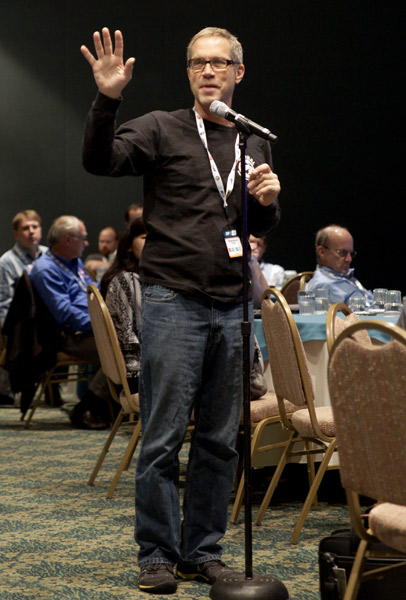Improving Rebreather Safety

First in a series of reports on Rebreather Forum 3 by Michael Menduno.
Rebreather Forum 3 staged in Orlando, Florida, saw the convergence of a rebreather diving ‘who’s who’ to discuss and debate this life support system that is hailed as the future of diving by some and anything but by others. What’s certain is that more rebreathers by more manufacturers are coming on the market, among them the new Type R, recreational diver rebreather. Here we present a series of six reports by contributor Michael Menduno who attended RF3 and who has a long association with technical and sport diving.
How can rebreather diving be made safer?
That was the question at the core of the numerous presentations and discussions at Rebreather Forum 3 (RF3) held in Orlando, Florida this May. Sponsored by PADI Inc., Diver’s Alert Network and the American Academy of Underwater Scientists (AAUS), the international conclave brought together over 400 industry insiders from the sport, scientific, media, and government diving communities along with a self-selecting group of high-end photographers and consumers, who came to talk rebreathers, learn, share experiences, network, ogle the latest gear and hopefully help steer the community forward. The last forum, Rebreather Forum 2.0, which I organized with rebreather builder Tracy Robinette, was held 16-years earlier in 1996, at a time when rebreathers were just being introduced to the sport diving market.
In his opening remarks, PADI CEO Drew Richardson proposed that the number one goal of RF3 was contributing to rebreather diving safety and reducing incidents. The issue is of critical importance today when manufacturers like Poseidon Diving Systems Ltd., and Hollis Inc., in conjunction with PADI and other training agencies, are now actively promoting rebreathers for use by recreational divers, which is a source of some controversy. Until recently, rebreather use was limited primarily to tech divers because of their complexity, operational requirements and cost. The concern is that rebreathers may be too complex and time consuming for a typical open water diver who is still mastering his/her basic diving skills. However, PADI has developed a simplified diving protocol using rebreathers designed specifically for recreational use that it believes will prove efficacious.
Though no one knows the actual risks, worldwide there have been more than 200 reported rebreather fatalities since 1998, averaging approximately 10 per year prior to 2005 and about 20 per year since. To put these numbers in perspective, on average there are about 100 to 120 scuba diving fatalities annually in the US, Canada, UK and Europe combined, which represents the majority of the worldwide market. Given that there are millions of open circuit divers compared to at most tens of thousands of rebreather divers, the fatality rate for rebreather diving is evidently much higher than its open circuit counterpart, as industry insiders are all too well aware.
During one of the opening sessions, Dr. Andrew Fock, head of hyperbaric medicine at The Albert Hospital in Melbourne, Australia asked for a show of hands in response to this question: “How many people in this room believe that the current rebreather safety record is acceptable?”
No one raised a hand.
Pushing the Envelope (Again)
Conceived in the 17th century by Giovanni Borelli, closed circuit rebreathers (CCR) remained an elusive invention until the advent of galvanic oxygen sensors in the early 1960s made their construction possible. Like simple, non-electronic oxygen rebreathers before them, the technology was primarily limited to military divers until the late 1980s when pioneers like Dr. Bill Stone, Olivier Isler, Stuart Clough and Rob Palmer began experimenting with rebreathers for cave exploration, just as technical diving was emerging.
Though the early tech community immediately seized upon their potential for extending bottom times and optimizing decompression, it took until the late 1990s for the first production units like the Cis-Lunar Mk-IV, Ambient Pressure Diving’s Inspiration and the KISS Classic to become available.
Today, rebreather diving represents one of the fastest growing areas of sport diving. Poseidon reported at the Forum that they sold more of their recreational Mk-VI rebreathers in the last four and half months, than in the prior two and half years, and PADI is certifying new recreational rebreather instructors to meet the demand. In certain countries, such as the UK, which is regarded as rebreather “ground zero,” it’s actually becoming rare to see a set of doubles on a dive boat.
Industry insiders estimate there are as many as 10,000 to 15,000 active rebreather divers worldwide, and there are more than a dozen rebreather manufacturers. At one of the forum sessions, the three oldest technical training agencies, ANDI, IANTD and TDI, which have been responsible for the majority of rebreather training to date, estimated that collectively they issued 30,000 basic, intermediate and advanced rebreather certifications from 1990-2011, and are currently trending at about 2500-3000 certs a year. (Data from the British Sub-Aqua Club, PSA International, and Rebreather Association of International Divers was not included). These numbers are likely to grow significantly as PADI recreational rebreather courses proliferate.
Though the number of users is still small, rebreather technology has greatly expanded the tech diver’s underwater envelope. It’s also been a boon to photographers/videographers and the early adopters among scientific and recreational divers, as evidenced by the conversation in Forum sessions chaired by explorer and instructor trainer Martin Robson.
Dives that would be logistically difficult or even impossible on open-circuit are routinely completed using rebreathers, and some explorers like Robson, Richard Harris and others are now pushing the limits of human physiology. During a Friday afternoon session, Harris detailed his team’s exploration dives to 680 feet (210m) at the Pearse River Resurgence (caves) in the South Island of New Zealand where divers are hitting up against the limits of “respiratory sufficiency”, and arguably surface-based diving.
However, as David Conlin, Chief of Submerged Resources Center for the National Park Service explained to the assembly, “The real value of rebreathers is not deep diving at all, but staying longer at 70-100 feet (20-30m). You can work at those depths nearly all day long when the conditions are good.” Conlin reported that rebreathers have increased Park Service diver productivity by nearly 40 percent. “We gain nearly one day for every three days we’re in the field,” he told the assembly.
 Writer and technologist Michael Menduno published and edited aquaCorps: The Journal for Technical Diving (1990-1996), which helped usher tech diving into the mainstream of sports diving, and coined the term “technical diving.” He also organized the first Tek, EuroTek and AsiaTek conferences, and Rebreather Forums 1.0 and 2.0. Menduno, who is based in Berkeley, CA remains an avid diver.
Writer and technologist Michael Menduno published and edited aquaCorps: The Journal for Technical Diving (1990-1996), which helped usher tech diving into the mainstream of sports diving, and coined the term “technical diving.” He also organized the first Tek, EuroTek and AsiaTek conferences, and Rebreather Forums 1.0 and 2.0. Menduno, who is based in Berkeley, CA remains an avid diver.
More from the forum:
Part 2
Part 3
Part 4
Part 5
Part 6
Leave a Comment







